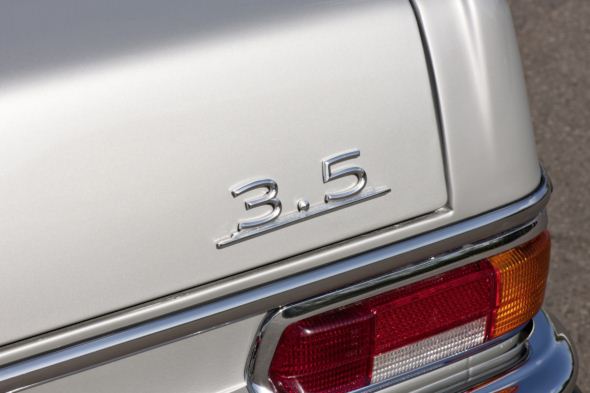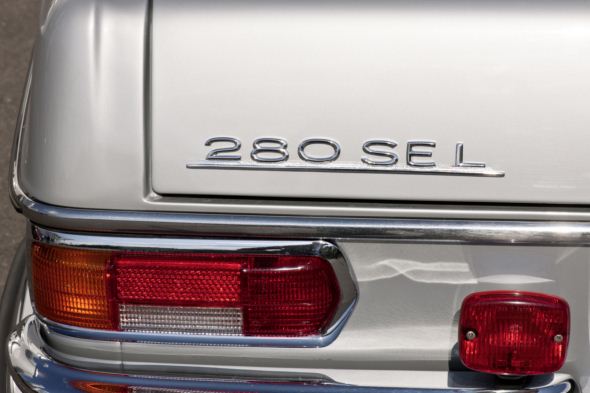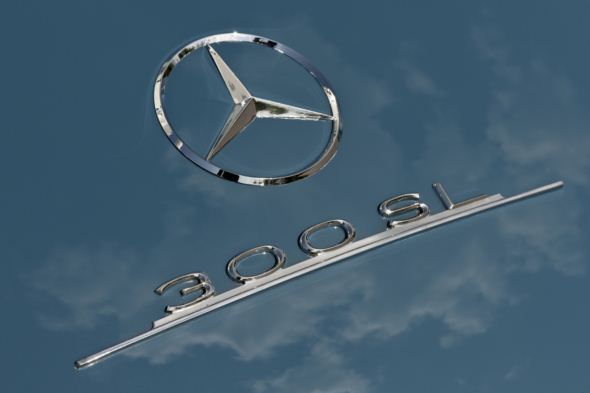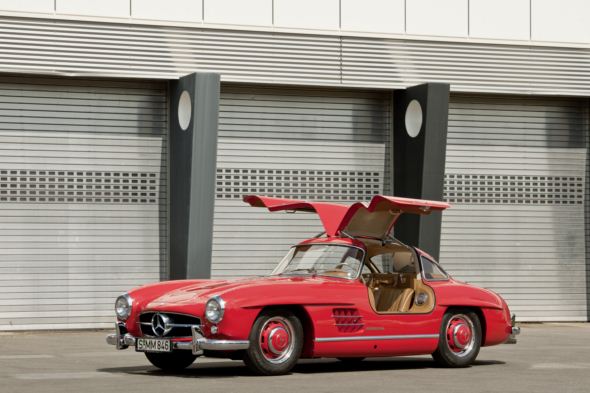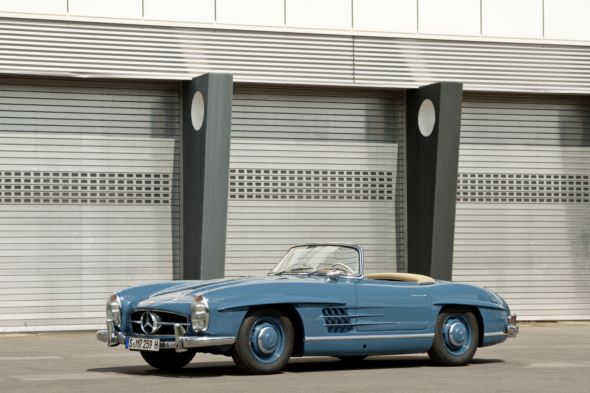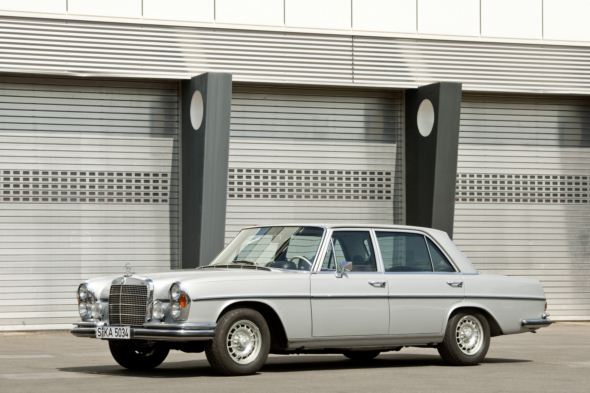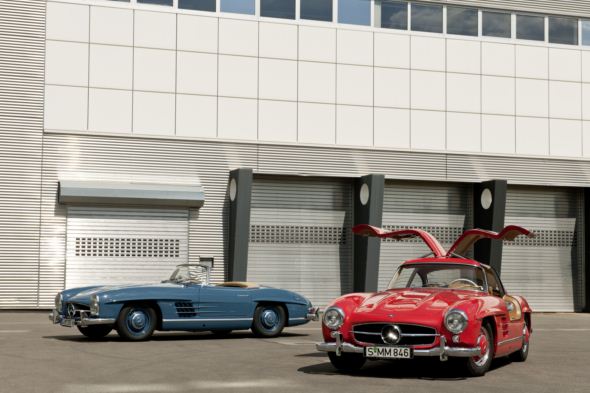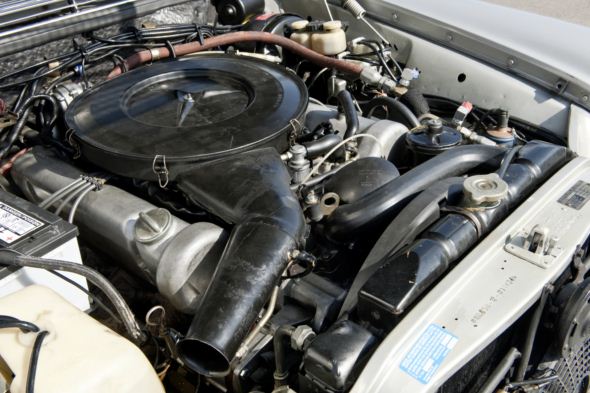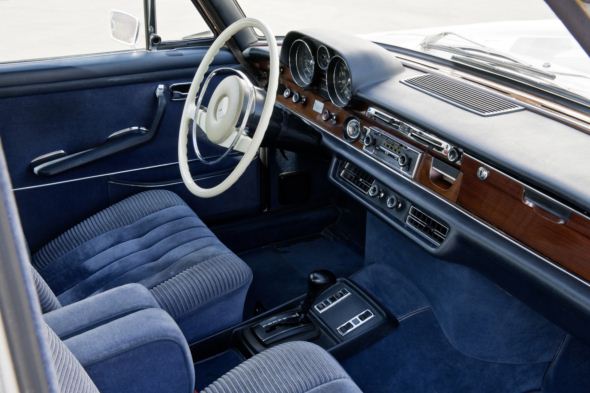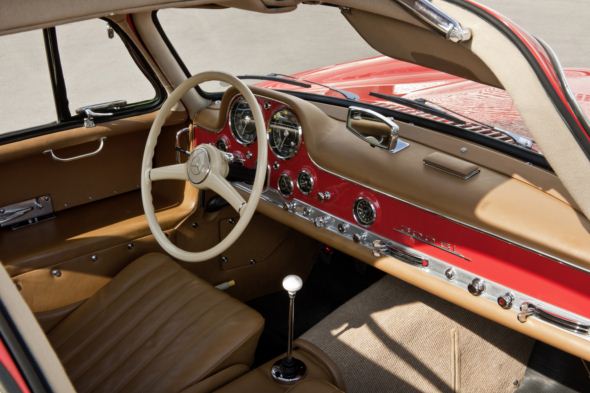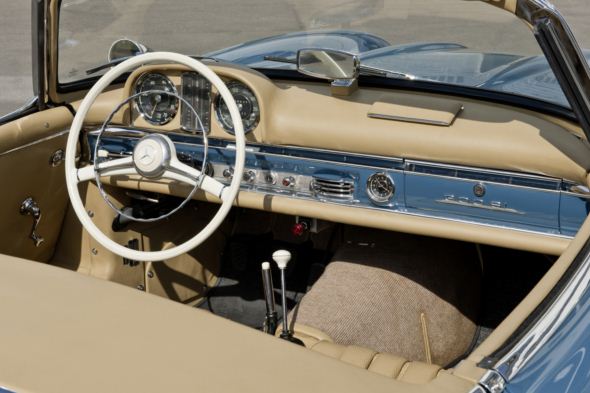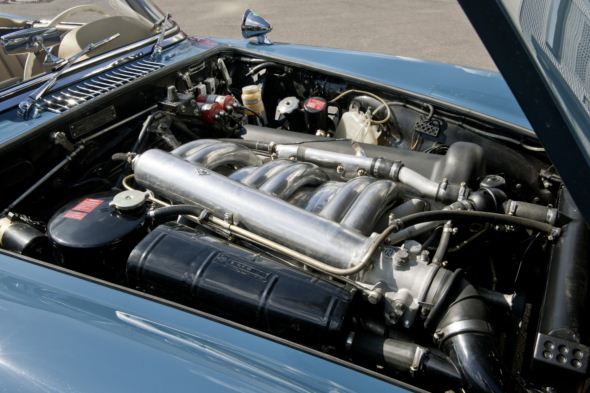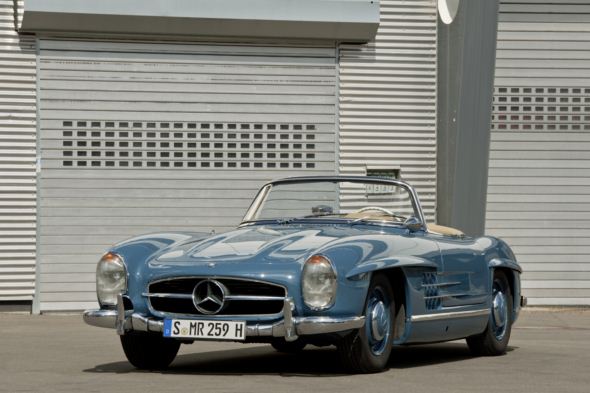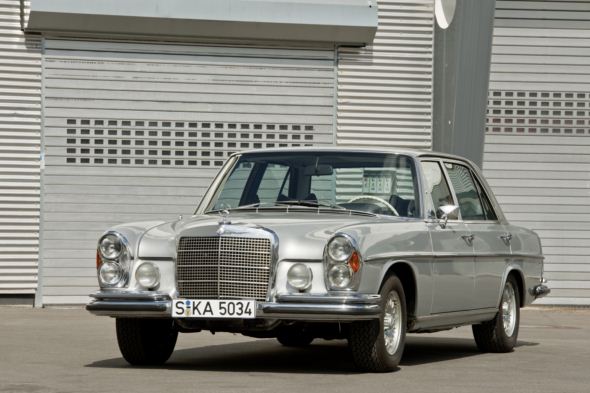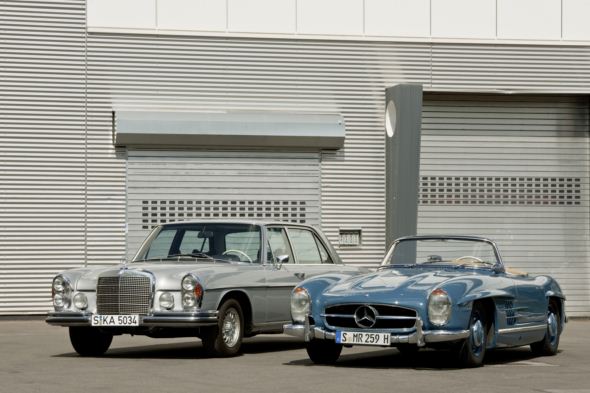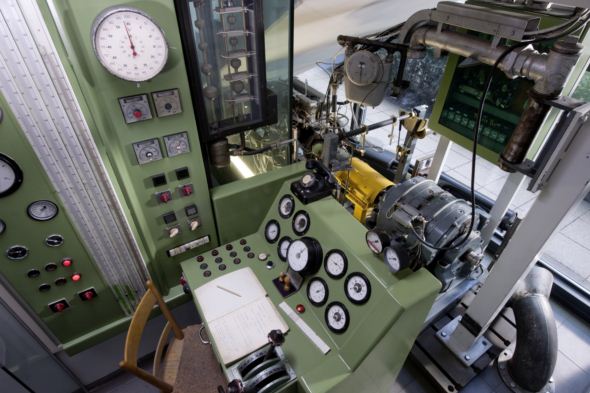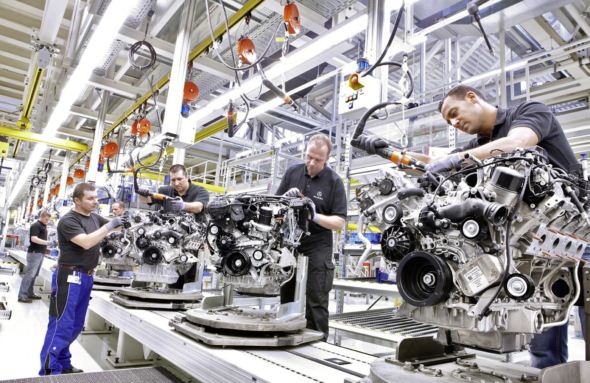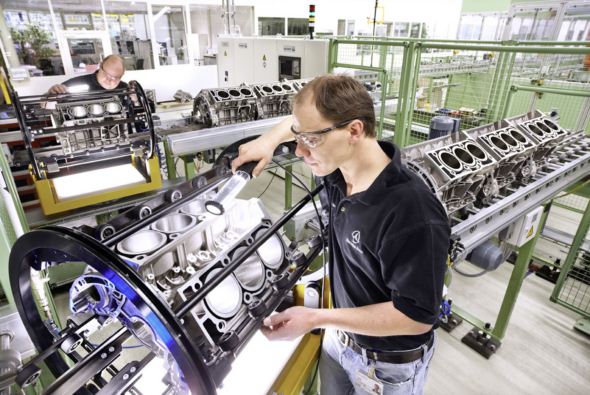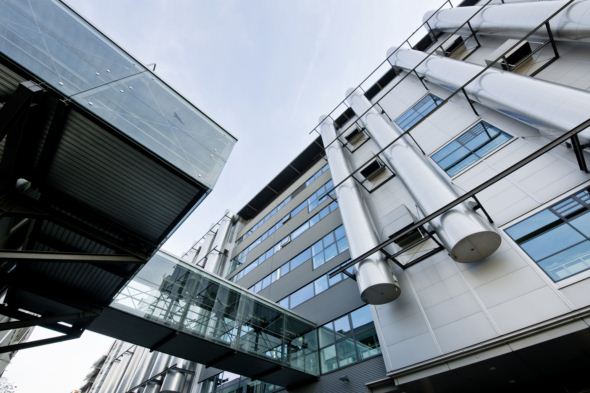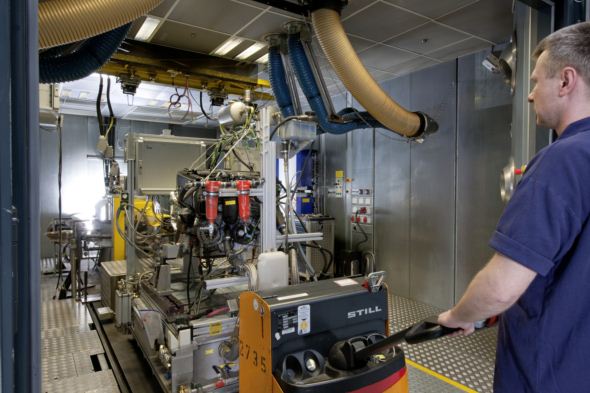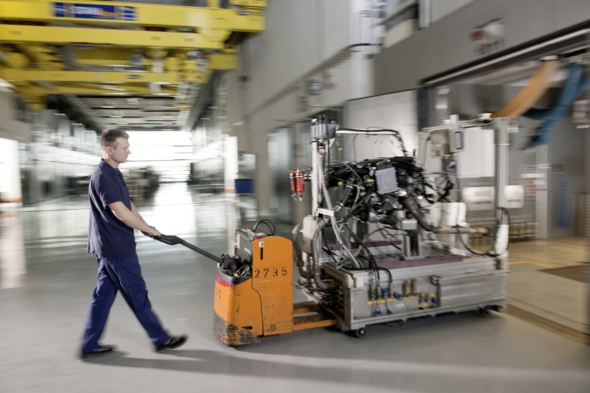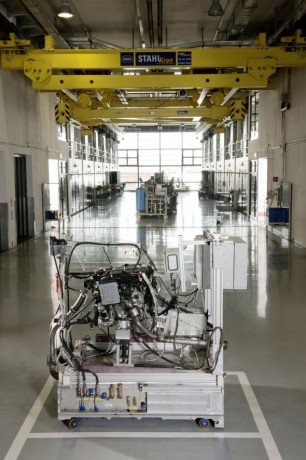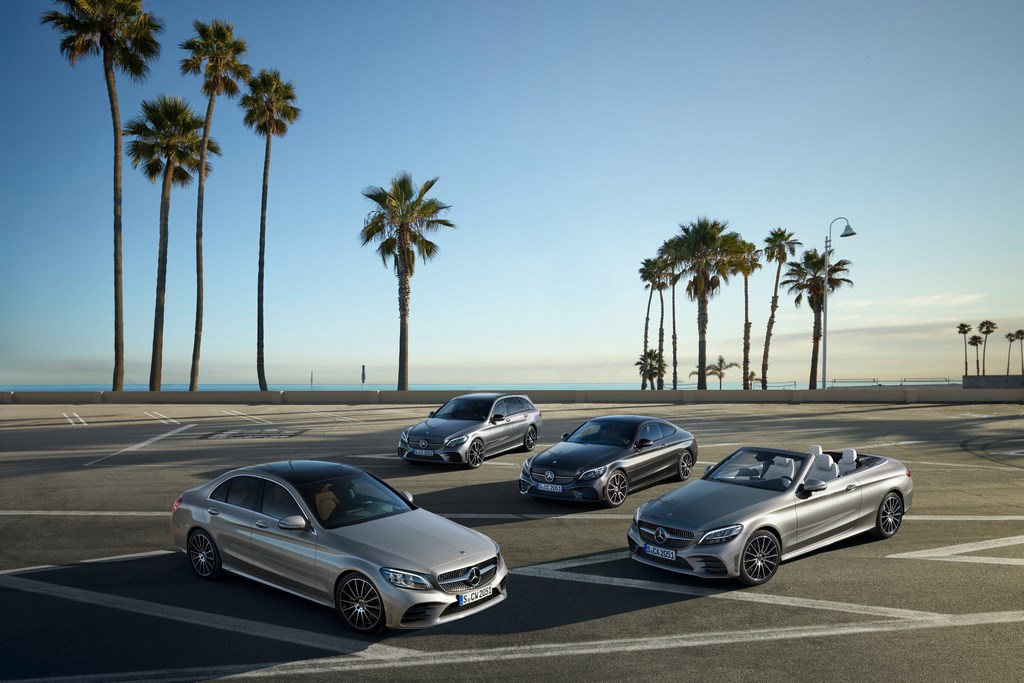New V8 and V6 engines with innovative technology from Mercedes-Benz

Quantum leap in efficiency: smooth refinement meets new dimensions in power and environmental compatibility

Stuttgart – Mercedes-Benz is setting previously unachievable efficiency standards in the premium segment with completely newly developed V6 and V8 engines. The new V8 engine has a displacement of 4663 cc and develops an output of 320 kW (435 hp), which is around 12 percent more than its predecessor despite approx. 0.8 litres less displacement. Torque has increased from 530 Nm to 700 Nm – i.e. by no less than 32 percent. Fuel consumption has however been reduced by 22 percent. With the same 3499 cc displacement as its predecessor, the new V6 engine develops 225 kW (306 hp). Torque has increased from 350 Nm to 370 Nm. Here too, the improvement in fuel efficiency is remarkable. The S 350 with the new V6 engine consumes an economical 7.6 litres per 100 kilometres, a saving of 24 percent compared to its predecessor.
Mercedes-Benz has achieved this considerable leap in efficiency with the use of a start/stop function as standard and other features such as newly developed, third-generation direct petrol injection with spray-guided combustion, multiple injection and multi-spark ignition. With this new generation of V-engines, Mercedes-Benz is clearly demonstrating that with concerted further development, internal combustion engines still have a great deal of potential, and that V6 and V8 engines with their great running refinement can continue to be used to good effect in the future.
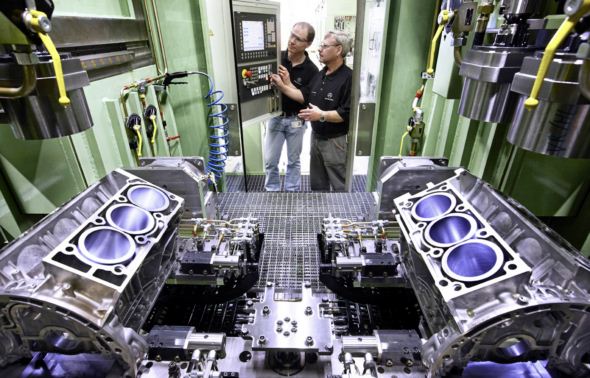
Considerably less fuel consumption despite a much higher output was the development objective for the new Mercedes-Benz V-engine generation, which will initially be used as an 8-cylinder in the CL-Class, and later in the S-Class from autumn 2010. Mercedes-Benz developed the new six and eight-cylinder units because optimised internal combustion engines continue to have specific advantages over other drive systems with respect to operating range and refuelling time and costs, while offering the greatest short-term potential to achieve significant fuel savings in day-to-day operation.
“The new six and eight-cylinder engines from Mercedes-Benz are a unique synthesis of effortless power delivery, comfort and efficiency,” says Dr. Thomas Weber, the member of the Daimler AG Executive Board responsible for corporate research and development at Mercedes-Benz Cars. “Both impress with refinement at the highest level, as well as exemplary environmental compatibility.”
The new Mercedes-Benz engine family is uncompromisingly based on modularisation. It allows the use of a start/stop function, 4MATIC all-wheel
drive and combination with a hybrid module.
The V8 is in a new league of its own
On the basis of its predecessor, the new V8 has undergone concerted further development. For example, it has a 15-percent smaller displacement (4663 cc rather than 5461 cc) but generates 320 kW (435 hp) and therefore around 12 percent more output than the preceding unit (285 kW/388 hp). Whereas the current CL 500 consumes 12.3 litres per 100 kilometres, this figure drops to 9.5 litres with the new engine – a reduction of 22 percent. CO2 emissions have likewise fallen by 22 percent, from 288 g/km to 224 g/km – an outstanding figure for this performance class. At the same time torque has been raised from 530 Nm to 700 Nm – an increase of 32 percent.
As the high maximum torque is already available from 1800 rpm, the new high-tech V8 already exhibits an outstanding power delivery at low engine speeds, together with smoothness and refinement that is remarkable even for an eight-cylinder.
In the new V8, Mercedes-Benz engineers primarily achieved a high output for a lower displacement by using two turbochargers — one for each bank of cylinders. The chargers were configured to provide high torque even at low engine speeds – compared to the previous engine the result is an increase of more than 40 percent at 2000 rpm. An outstanding 600 Nm is available between 1600 and 4750 rpm. The driver therefore perceives no turbo delay, but experiences the same pleasant and effortless performance from the new V8 as that delivered by a mighty, naturally aspirated 7-litre engine.
The V6 particularly impresses with its low fuel consumption
The new V6 engine is naturally aspirated, and has the potential for future use of a turbocharger thanks to the modular design concept. The most striking change between the new V6 unit and its predecessor is a reduction in the V-angle between the cylinder banks from 90 degrees to 60 degrees. This enabled the balancer shaft countering primary vibrations to be omitted, and as a result the driver registers an outstanding level of comfort.
A completely new intake and exhaust gas system with a variable-resonance intake manifold and optimised airflows was also developed for the new V6. This enabled the output of the 3499 cc engine to be increased to 225 kW (306 hp) (Previous engine of the same displacement in the S-Class: 200 kW/272 hp). Torque has increased from 350 Nm to 370 Nm, and is available between 3500 and 5250 rpm.
The improvement in fuel consumption is particularly remarkable. The S 350 with the new V6 engine consumes just 7.6 litres per 100 kilometres (CO2 emissions: 177 g/km), which makes it 24 percent more economical than its predecessor (10.0 l/100 km). It also makes the new V6 the benchmark in its segment for a comparable output (provisional figures).
Innovative technology makes V6 and V8 engines fit for the future
Both the new V6 and the new V8 from Mercedes-Benz have aluminium crankcases, pistons and cylinder heads. The crankshaft, connecting rods and valves are of special forged steel.
The technology package in the new engine generation includes a number of new developments that are unique in this combination:
- In combination with multi-spark ignition, a further developed, third generation direct fuel injection system with spray-guided combustion and piezo-electric injectors offers further possibilities for fuel savings – in the V8 by means of an improved, homogeneous combustion process, and in the V6 by a new, stratified combustion process with a considerably extended characteristic map and fuel-efficient lean-burn technology.
- In conjunction with start/stop technology, shift point adjustment and specific friction-reducing measures, improvements in day-to-day fuel consumption by more than 20 percent are possible.
- Power consumption by ancillary units has been reduced. These include an optimised water pump with 2nd-generation thermal management, a demand-controlled oil pump, a volume-controlled high-pressure fuel pump and an intelligent generator management system.
Lightweight construction techniques and detailed improvements have also reduced in-engine friction considerably compared to the previous engine.
With its new-generation V-engines, Mercedes-Benz is clearly demonstrating that with concerted further development, internal combustion engines still have a great deal of potential, and that V6 and V8 engines with their high level of refinement are fit for the future.
Mercedes-Benz sets benchmarks
Innovative technology makes V6 and V8 engines economical and fit for the future
- High output and exemplary environmental compatibility
- Third generation direct petrol injection
- Multi-spark ignition
- Optimised water pump and demand-controlled oil pump
- Optimised timing chain and innovative camshaft adjustment
Considerably less fuel consumption despite a much higher output was the result of the development work for the new Mercedes-Benz V-engine generation, which will initially be used as an 8-cylinder in the CL-Class and later the S-Class from autumn 2010. Mercedes-Benz developed the new six and eight-cylinder units because optimised internal combustion engines continue to have specific advantages over other drive systems with respect to operating range and refuelling time and costs, while offering the greatest short-term potential to achieve significant fuel savings in day-to-day operation. An internal combustion engine is also the centrepiece of a hybrid drive system, and of decisive importance for improved efficiency.
The new Mercedes-Benz engine family is uncompromisingly based on modularisation and innovative technologies, and replaces a very successful engine series. It allows the use of a start/stop function, 4MATIC all-wheel drive and combination with a hybrid module.
The V8 is in a new league of its own
While the new V8 is based on its predecessor and has the same distance between the cylinders, it has undergone concerted further development in every respect. For example, it has a 15-percent smaller displacement (4663 cc rather than 5461 cc) but generates 320 kW (435 hp) and therefore around 12 percent more output than the preceding unit (285 kW/388 hp). Whereas the current CL 500 consumes 12.3 litres per 100 kilometres, this figure drops to 9.5 litres with the new engine – a reduction of 22 percent. CO2 emissions have likewise fallen by 22 percent, from 288 g/km to 224 g/km – an outstanding figure for this performance class. At the same time torque has been raised from 530 Nm to 700 Nm – an increase of 32 percent. In terms of specific output, the new V8 with 68.6 kW and 150 Nm per litre achieves first-class values.
In the new V8, Mercedes-Benz engineers primarily achieved a high output for a lower displacement by using two turbochargers — one for each bank of cylinders. The intake air is forced into the eight combustion chambers at an overpressure of up to 0.9 bar, with the turbine blades rotating at up to 150,000 rpm. The turbochargers and their hot gas ducting are accommodated on the outsides of the cylinder heads. This enabled the intercooler module with its air/water intercooler and charge-air distributor to be located inside the V of the engine.

The chargers were configured to provide high torque even at low engine speeds – compared to the previous engine, the result is an increase by more than 45 percent at 2000 rpm. No less than 600 Nm is available between 1600 and 4750 rpm.
The engine is based on a further development of the previous engine’s die cast aluminium crankcase with cast-in aluminium/silicon (Silitec) cylinder liners. Basic and connecting rod journal diameters were adopted from the preceding engine, while for load reasons the piston compression height was raised by just under four millimetres. By reducing the lift and shortening the connecting rod by 2 millimetres, it was possible to retain the interior height of the crankcase. As a remarkable feature, the high compression ratio of 10.5:1 remains unchanged versus the naturally aspirated preceding engine, showing the high efficiency of the new, turbocharged V8 when configured for premium fuel (RON 95).
Key figures for the new V8 engine
| No. of cylinders | V8 |
| Displacement (cc) | 4633 |
| Bore (mm) | 92.9 |
| Stroke (mm) | 86 |
| Compression ratio | 10.5:1 |
| Output (kW at rpm) | 320 at 5250 |
| Torque (Nm at rpm) | 700 from 1800-3500 |
The V6 particularly impresses with its low fuel consumption
In contrast to the V8 the new V6 engine is naturally aspirated, and has the potential for future use of a turbocharger thanks to the modular design concept. The most striking change between the new V6 unit and its predecessor is a reduction in the V-angle between the cylinder banks from 90 degrees to 60 degrees. This enabled the balancer shaft countering primary vibrations to be omitted, and as a result the driver registers an outstanding level of comfort.
A completely new intake and exhaust gas system with a variable-resonance intake manifold and optimised airflows was also developed for the new V6. This enabled the output of the 3499 cc engine to be increased to 225 kW (306 hp) (Previous engine of the same displacement in the S-Class: 200 kW/272 hp). Torque has increased from 350 Nm to 370 Nm, and is available between 3500 and 5250 rpm.
The improvement in fuel consumption is particularly remarkable. The S 350 with the new V6 engine consumes just 7.6 litres per 100 kilometres (CO2 emissions: 177 g/km), which makes it 24 percent more economical than its predecessor (10.0 l/100 km). It also makes the new V6 the benchmark in its segment for a comparable output (provisional figures).
Key figures for the new V6 engine
| No. of cylinders | V6 |
| Displacement (cc) | 3499 |
| Bore (mm) | 92.9 |
| Stroke (mm) | 86 |
| Compression ratio: | 12.2:1 |
| Output (kW at rpm) | 225 at 6500 |
| Torque (Nm at rpm) | 370 from 3500-5250 |
Innovative technology makes V6 and V8 engines fit for the future
Both the new V6 and the new V8 from Mercedes-Benz have aluminium crankcases, pistons and cylinder heads. The crankshaft, connecting rods and valves are of special forged steel.
Mercedes-Benz has achieved this considerable leap in efficiency with the use of innovative technology – including newly developed, third-generation direct petrol injection with spray-guided combustion, multiple injection and multi-spark ignition. With this new generation of V-engines, Mercedes-Benz is clearly demonstrating that with concerted further development, internal combustion engines still have a great deal of potential, and that V6 and V8 engines with their great running refinement are fit for the future.
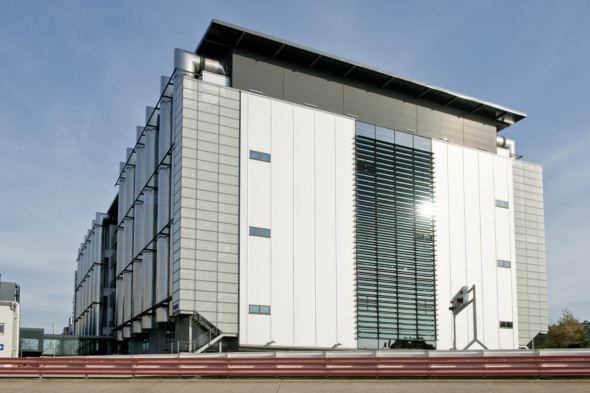
The technology package in the new engine generation includes a number of new developments that are unique in this combination:
- In combination with multi-spark ignition, a further developed, third generation direct fuel injection system with spray-guided combustion and piezo-electric injectors offers further possibilities for fuel savings – in the V8 by means of an improved, homogeneous combustion process, and in the V6 by a new, stratified combustion process with a considerably extended characteristic map and fuel-efficient lean-burn technology.
- In conjunction with start/stop technology, shift point adjustment and specific friction-reducing measures, improvements in day-to-day fuel consumption by more than 20 percent are possible.
- Power consumption by ancillary units has been reduced. These include an optimised water pump with second generation thermal management,
a demand-controlled oil pump, a volume-controlled high-pressure fuel pump and an intelligent generator management system.
Lightweight construction techniques and detailed improvements have also reduced in-engine friction considerably compared to the previous engine.
Third generation direct petrol injection
Direct petrol injection with spray-guided combustion, which Mercedes-Benz was the first car manufacturer to introduce in series production, has been developed further as a third generation. The system pressure is up to 200 bar, the pressure being variably optimised according to the engine’s characteristic map. Completely newly developed piezo-electric injectors allow up to five injections per intake stroke for the best possible mixture formation.

The crystalline structure of the piezo-ceramic changes in microseconds under an electric voltage, and with a precision of just a few thousandths of a millimetre. The central component of a piezo-electric injector is the piezo-stack, which directly controls the metering needle. With a response time of just 0.1 milli-seconds, the fuel injection can be very sensitively and precisely adjusted to the current load and engine speed, with a beneficial effect on emissions, fuel consumption and combustion noise.
The multiple injections even in tiny quantities made possible with piezo-electric injection technology were used by Mercedes-Benz engineers to control a wider characteristic map with the efficient lean-burn process, and to provide the conditions for further functions:
- As the first new operating mode, Mercedes-Benz engineers have developed “Homogeneous stratified combustion” (HOS). As the name implies, HOS is a combination of homogeneous lean-burn and classic stratified combustion. The first injection is sprayed into the intake stroke, forming a homogeneous basic mixture. Actual “stratified” injection takes place during the compression stroke before ignition, and is a single or double injection depending on the characteristic map.
- Another new operating mode is known as “Homogeneous Split” (HSP). In this homogeneous combustion process, more than 95 percent of the fuel is singly or multiply injected, followed a very small “ignition” injection to stabilise combustion. This is used when combustion conditions are difficult.
The characteristic map of the new Mercedes-Benz V6 engine is therefore basically divided into up to four areas:
– idling range (homogeneous)
– low partial load up to 4 bar and 3800 rpm (stratified)
– medium partial load 4 to 8 bar and up to 4000 rpm (HOS)
– high load and entire engine speed range (homogeneous or HSP)
The V8 engine is operated homogeneously over the entire characteristic map, but under high load homogeneous or HSP operation is used to improve smooth running characteristics:
Multi-spark ignition for optimal efficiency
The third-generation direct injection system also features rapid multi-spark ignition (MSI). Following the first spark discharge and a brief combustion period, the coil is rapidly recharged and a further spark is discharged. The MSI system enables up to four sparks to be discharged in rapid succession within one millisecond, creating a plasma with a larger spatial expansion than conventional ignition.
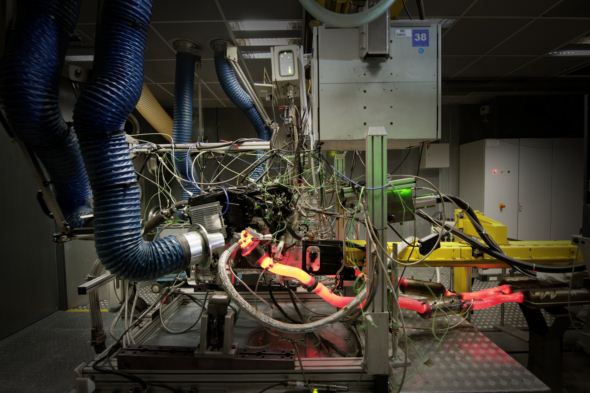
Controlling this rapid multi-spark ignition enables both the time lapse before the next spark and the combustion duration for the relevant operating point to be optimally adjusted. This provides scope for optimising the centre of combustion and improving residual gas compatibility, especially during stratified charge operation. Fuel consumption can be reduced by roughly two percent in this way.
Fuel savings of up to four percent are possible alone by the use of piezo-electric injection technology in combination with multi-spark ignition, depending on the driving cycle.
Cylinder head with new camshaft adjuster
On the basis of the previous engine’s architecture, Mercedes-Benz engineers developed the variable, hydraulic vane-type camshaft adjusters for the intake and exhaust sides. These now have a larger adjustment range of 40 degrees with reference to the crankshaft. They were also able to improve the functionality, achieving a 35-percent greater adjustment speed and adjustability at an oil pressure as low as 0.44 bar.
Despite the better performance, this new development excels with significantly smaller dimensions and low weight. For this reason the installation space on the longitudinal and vertical axes of the engine was able to be reduced by around 15 millimetres.
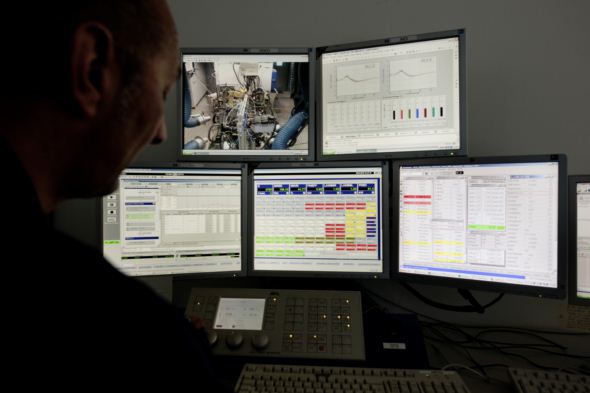
Two-stage chain drive for low noise
The extreme compactness of the camshaft adjusters was achieved by the new, two-stage chain drive. This drives short secondary chains – one per cylinder
bank – via a primary chain and an intermediate gear. All three chains can be individually adjusted via a chain tensioner. This results in low tensioning forces and low chain dynamics, ensuring consistent timing and outstanding acoustic properties, with friction reduced even further. In short, the new chain drive is compact and ensures low-noise operation.
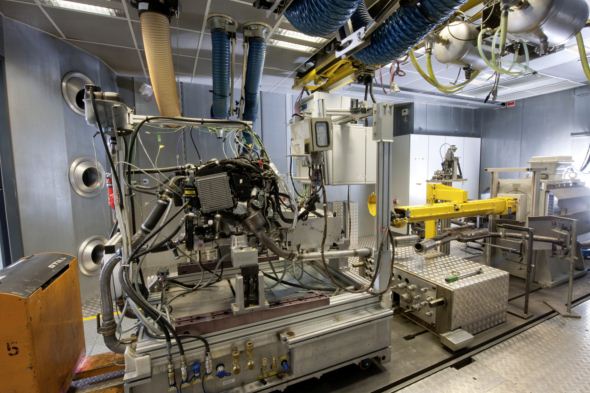
Controlled oil pump with two pressure stages
A fourth chain drivers a likewise completely newly developed, variable vane-type oil pump. The operates with two pressure stages, depending on the characteristic map. At low engine speeds and loads the pump runs at a low pressure of two bar. At this time the oil-spray nozzles for piston cooling are switched off. The high-pressure stage is activated at the upper load and engine speed levels. Thanks to this control concept, the lubrication and cooling points of the engine can be supplied with significantly lower drive energy than would be possible with an uncontrolled pump.
New coolant ducting and 3-phase thermal management
The coolant ducting in the cylinder head is also completely new. The water mantle is of two-piece construction to improve flow. This leads to specific increases in flow speeds and heat dissipation at certain points, accompanied by a reduction in pressure throughout the coolant circuit. This has made it possible to reduce the power output of the water pump despite an increased engine output.
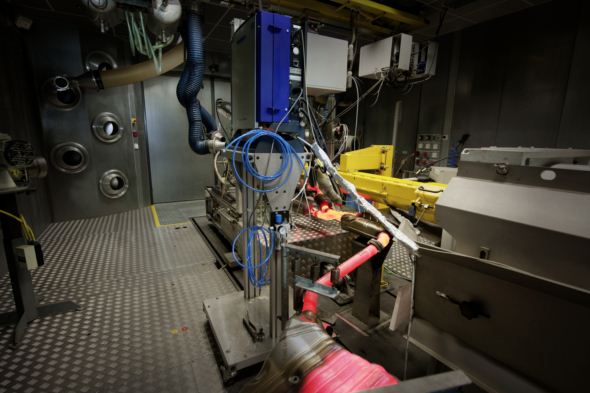
As it warms up, the flow of coolant is regulated by a 3-phase thermal management system so that it rapidly reaches normal operating temperature. Initially the coolant remains at rest in the engine. It then circulates in the engine circuit, but without the radiator. When a temperature of 105 degrees Celsius has been reached in normal operation (87 degrees Celsius under high load), the vehicle’s radiator is included in the circuit. The water supply to the interior heating system is separately controllable.
Component weights have also been reduced by the concerted replacement of aluminium and steel by plastics, e.g. for the thermostat, belt pulley, wheel, heater valve and hydraulic lines.
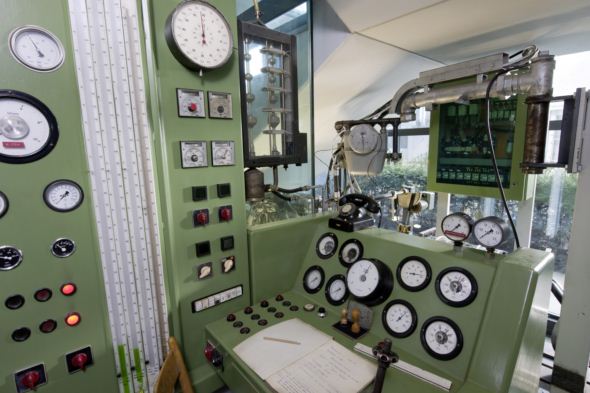
Start/stop function with direct-start
The new start/stop system operates with starter-supported direct-start. This means that when the engine is switched off, the attitude of the crankshaft is registered by a new crankshaft sensor so that the engine control unit knows the positions of the individual pistons. On restarting, it can then select the cylinder that has the most suitable piston position for first ignition. After the starter has briefly turned over the engine, reliable injection, ignition and combustion is immediately possible.
Minimised friction
Particular attention was paid to reduced friction in both engines. This was primarily achieved by a reduction in flow through the oil and water pumps, low-friction pistons, piston rings and cylinder walls, plus the new thermal management system and chain drive.
Fit for the future thanks to modular construction
The new V-engines from Mercedes-Benz are fit for the future. They can not only be combined with a start/stop function, but also coupled with the 4MATIC four-wheel drive system or integrated into a hybrid drive system.
The new engines meet all worldwide emissions regulations. The use of third generation, direct petrol injection with spray-guided combustion and piezo-electric injectors provides a particularly good basis for increased stringency in the future.
Development, trials and test bench technology:
Endurance test for the new V-engines
- 52,000 hours of test bench trials
- Seven million kilometres of test drives
- 2 million core hours of computer calculation per year
Before the new V6 and V8 engines were allowed onto the roads, they had already absolved a series of torturous trials, for example on the engine test benches of the test facility in Untertürkheim. 24 of the very latest engine test benches are installed on each floor of this imposing three-storey building. These 72 test benches are in operation by day and night, otherwise it is impossible to complete the enormous test programme to which Mercedes-Benz engineers subject all engines.
A wide range of road and load situations can be simulated on the test benches, reflecting every conceivable operating profile such as hot and cold starts, stop-and-go and long-distance driving under very varied conditions. All in all, the new V8 engines from Mercedes-Benz and their ancillary units were required to absolve 52,000 test hours, of which 27,000 were endurance runs.
In parallel with this, extensive practical trials were started in all the climatic zones of the world – in the winter cold of the Arctic and the merciless heat of Death Valley (USA), in desert sands and the thin air of Alpine regions or in tropical jungles. The programme also included fast laps on e.g. the high-speed racetracks in Nardo (Italy) and Papenburg, as well as stop-and-go driving in busy inner-city areas. All in all, the different test vehicles with the new V8 engine covered almost seven million kilometres under very varied conditions. Similar figures apply to the V6 engine.
Naturally the development process began well before these practical trials – namely on the computer screens of the development engineers. This is where the fundamental design calculations were made with the help of modern computers. All the mechanical functions were conceived and alternatives compared here, e.g. the oil and coolant circuits, the various options for intake air ducting, the charging strategy, combustion chamber geometry incl. the intake and exhaust duct, as well as the multiple injection system. All were created and calculated on-screen.
1,800 computer cores provided the necessary computing power for this development process. More than two million core hours were needed to calculate and verify all the engine functions and components for the best possible result.
Without the very latest computers, it would not have been possible to explore technical boundaries and use new processes such as multiple injection. This is because the engineers not only used this enormous computing power for design calculations, but also for the simulation and testing of all engine functions.
Finally the engineers used PCs to establish the best possible configurations for all components, so that they met precisely formulated criteria and could be approved for production of the first prototypes. After this exhaustive verification process, the first engines in the new V-engine generation from Mercedes-Benz immediately ran reliably and met all expectations on the test bench.
A short history of injection engines
Mercedes-Benz is a pioneer in direct petrol injection
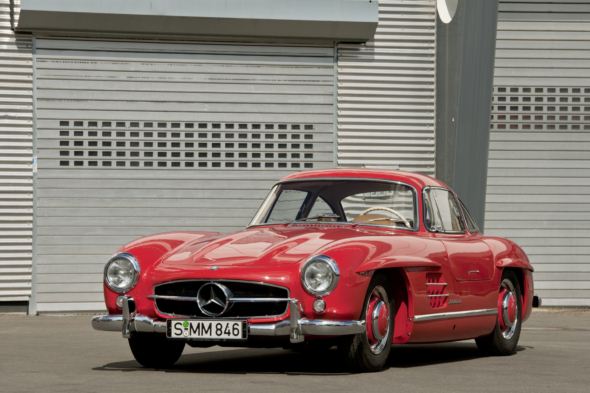
- The legendary 300 SL was the trailblazer
- First petrol engine with piezo-electric direct injection and spray-guided combustion
In 1954 Mercedes-Benz equipped the legendary 300 SL with a four-cylinder engine featuring direct petrol injection as a world first for series production cars. Since then, the company has pioneered direct petrol injection technology for cars with ongoing further development and improvements.
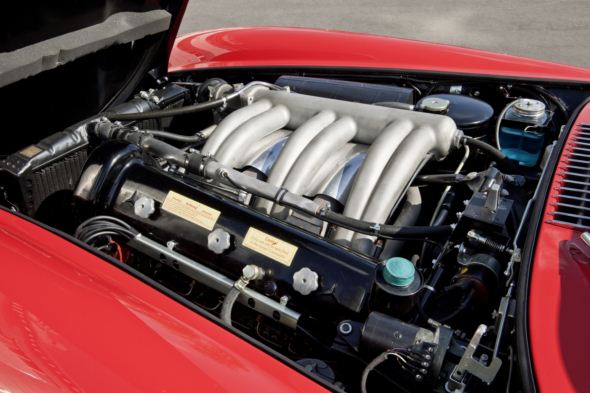
In 1994, the researchers and engineers at Mercedes-Benz entered new technological territory when they began the development of a spray-guided combustion process. In the view of specialists, this offers the greatest potential for mastering two of the major automotive engineering challenges of the future, namely further reductions in fuel consumption and exhaust emissions.
At the end of 2002 Mercedes-Benz presented a new development stage in direct petrol injection with the new 1.8-litre CGI four-cylinder engine. CGI stands for “Stratified Charge Gasoline Injection”.
The second-generation CGI process reached a new level in the CLS 350 CGI introduced in 2006: the four-door coupé featured the world’s first petrol engine with piezo-electric direct injection and spray-guided combustion. This six-cylinder unit achieved a fuel saving of around ten percent versus the V6 petrol engine with port injection.
The present state of the art is now reflected by the new V6 and V8 engines with third-generation direct injection and multi-spark ignition. They combine a high output with excellent economy and environmental compatibility, and offer refinement at the highest level. They set previously unachieved benchmarks
in the premium segment for Mercedes-Benz.
Engine Production
The cradle of engine design
- A success story from the outset
- State-of-the-art engine technology
- Exemplary approach to environmental protection at the plant
Bad Cannstatt has a long and successful history as the birthplace of Mercedes-Benz engines. For 125 years ago this was where Gottlieb Daimler and Wilhelm Maybach built their “grandfather clock” – the world’s first single-cylinder engine. It was to become a pioneering invention which simultaneously marked the birth of automotive mobility. Today, just a stone’s throw from Daimler’s famous greenhouse – the original scene of these activities – is located the most recent sub-plant of the Untertürkheim plant, the V-engine factory at Bad Cannstatt.
This “factory of the future” was officially opened in 1997. For the first time the all-new engine series for 6 and 8-cylinder engines was produced using the same state-of-the-art production facilities. Even then, the objective was to achieve efficient production using as many common components as possible for the variants of the new engine series. With a high output of unit numbers, this meant reduced costs – which ultimately also benefited the customer. The decision to locate to Bad Cannstatt at the time involved an investment worth approximately 1 billion Deutschmarks, 700 million DM of which were earmarked for plant construction and equipment alone.
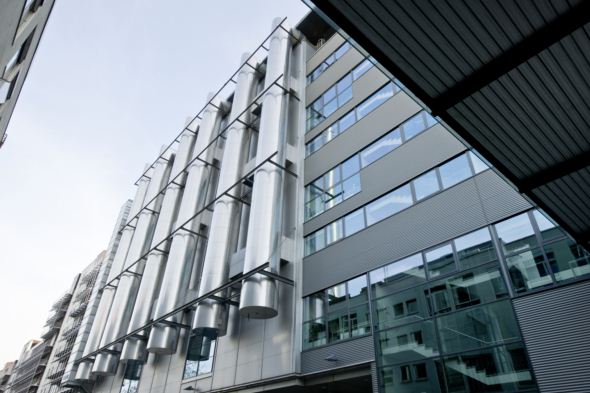
In 2004 the original production area of 66,300 square metres was expanded by around 18,000 square metres to 84,200 square metres. With a workforce of around 900 employees, the specialist V-engine production facility is today a key part of the production network. Since its official opening, over four million examples of the V-engine duo have already come off the assembly lines at the Cannstatt plant. And this success story is set to continue with production of the new series. In addition to pure engine assembly, Cannstatt is also responsible for the mechanical processing of key components such as crankcases, crankshafts, con rods and cylinder heads.
- Envirtonmental protection as a matter of routine
Even at its official opening the Cannstatt plant was considered proof that efficient production, ecological commonsense and attractive jobs were not necessarily mutually exclusive. Here, minimum energy requirements went hand in hand with the optimum use of all resources. This involved, for example, minimising waste materials and recycling process fluids and chips from mechanical processing. With its closed-loop process recycling systems, Cannstatt is almost completely free of wastewater and waste materials, and the plant falls well within legal limits for clean gas values.
The Bad Cannstatt plant has set new standards with approaches that combine the utilisation of waste heat and heat recovery with an advanced photovoltaic system. The solar panelling – which covers an area of 5,000 square metres and at the time was one of the largest systems found anywhere in the world – generates an annual energy output of 350,000 kWh. This is sufficient to meet the electricity needs of more than 120 homes. The electricity generated is fed directly into the plant grid.
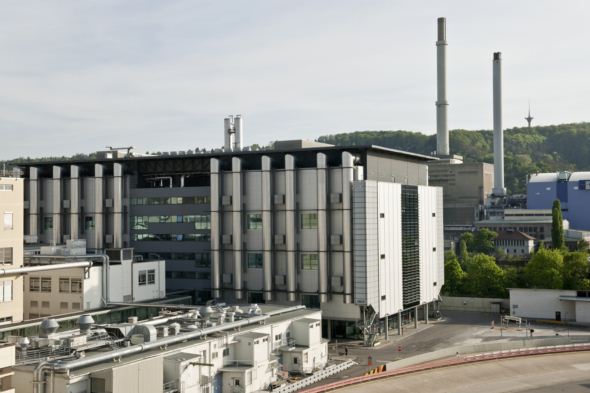
- For production of the new series the plant adopted the award-winning principle of minimum quantity lubrication, which involves mixing minimum quantities of lubricant with cold air instead of using conventional cooling lubricant. The new process uses a fraction of the volume of cooling lubricant previously used. Since these substances are manufactured from petroleum and demand both energy and cost intensive preparation, the innovation of minimum quantity lubrication represents an enormous cost advantage and a significant contribution to environmental protection.
- In addition, a true eco-paradise has been created on the outskirts of the plant. The “Neckar gravel bed” concept was developed in collaboration with environmental and nature conservation associations. After replicating a Neckar meadow over an area of 4,000 square metres – complete with its own characteristic heat islands and warm microclimate – it has been shown that 40 species of wild bee have now found a new habitat.
The Cannstatt plant in focus:
| Total area Production area | 150,000 m² 84,200 m² |
| Employees | 900 |
| Official plant opening | April 1997 |
| Products | V6 and V8 petrol engines |
